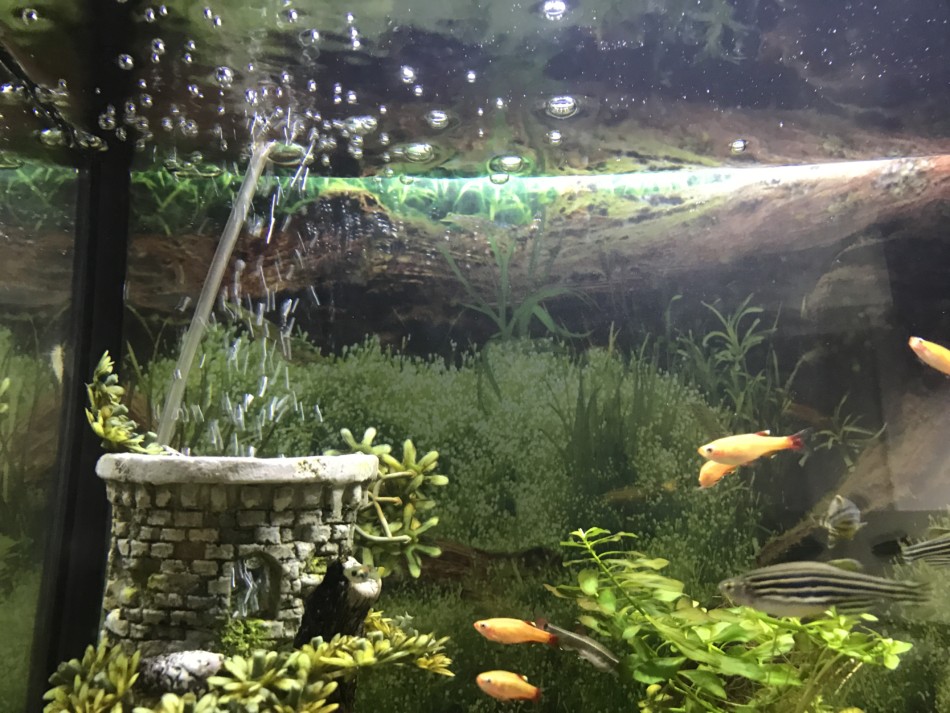This article may contain some affiliate links to products. The links provide me a small percentage of commission but do not cost you anything extra to use. (See full disclosure statement here ).
).
If you need or want to increase the oxygen level in your fish tank adding an air stone is an easy way to do it. Air stones also provide other beneficial effects in your aquarium in an affordable and simple way.
Air stones oxygenate aquarium water by releasing air bubbles. The bubbles rise up and break through the water’s surface tension allowing oxygen to enter the water. The resulting small splashes of water landing back into the tank break the surface tension once again which further increases oxygenation. And because the water movement is increased this adds to the tank’s oxygen intake too.
Increasing the oxygen level is only one of the benefits of having an air stone in your aquarium. There are other things that air stones do for your tank.
Let’s take a look at the other benefits and whether you need to add an air stone to your tank
Are Air Stones Good For Fish Tanks?
Using an air stone can be good for your fish tank depending on what you need it to do. I’ve listed the benefits of aquarium air stones below so that you can see what differences they make to a fish tank.
- Air stones increase the oxygen level in the tank water.
- Air stones break the surface tension of the water letting in oxygen and letting bad gases out. This makes gas exchange more efficient. Which in turn makes the water healthier for your fish.
- Air stones increase water movement which speeds up water flow in the tank. So if your fish like a little more current adding an air stone is helpful.
- Air stones create a decorative plume of bubbles which adds to the overall look of the tank.
So, unless you keep fish that only need minimal flow/current in the water, adding an air stone is likely to be good for your aquarium.
Do Air Stones Need A Pump?
Aquarium air stones are powered by using an air pump. So you will need a pump to operate the stone. The pump forces air into the stone through an air tube. The air is then released through the stone to create bubbles. Air pumps come in different shapes and capacities so you need to choose one that is suitable for your tank.
An adjustable air pump (Amazon link) is a good idea because you can alter the flow of air to change the amount of bubbles and flow to suit the needs of your fish and their tankmates.
(Amazon link) is a good idea because you can alter the flow of air to change the amount of bubbles and flow to suit the needs of your fish and their tankmates.
Air stones vary in size and shape too, but they all need air pumped through them for them to work. Which type of air stone you choose is up to you and what you have in mind for your aquarium. Air stones (Amazon link) are also called bubblers and diffusers but they are basically the same thing and do the same job.
(Amazon link) are also called bubblers and diffusers but they are basically the same thing and do the same job.
It’s worth noting that if you only need an air pump to run an air stone and not your filtration system it doesn’t have to be overly powerful. Just powerful enough to run the air stone in the way you want to use it is enough.
How Do You Use An Air Stone In A Fish Tank?
Air stones are simple and easy to use in your aquarium. You just attach the stone by its ‘nozzle’ to a length of aquarium air line tubing. Then push the other end of the tubing onto the outlet of the air pump and you’re set to go. Make sure you follow the safety/installation instructions on the air pump though.
You need to judge the length of air line tubing you will need before cutting it. It’s best to leave extra length that needs trimming rather than cutting it too short. And don’t forget to leave enough length to create a drip loop as a safety measure.
You should sit the air pump higher than the level of the tank water. This will reduce the risk of water backflow into the electric air pump during normal use.
It’s also advisable to use a check valve (Amazon link) to stop tank water flowing back into the pump during tank maintenance or a power cut/outage.
(Amazon link) to stop tank water flowing back into the pump during tank maintenance or a power cut/outage.
Check valves are sometimes called non-return valves depending on the manufacturer and where you live.
To add a check valve you cut the air line tubing then add the valve by pushing the ends of the tubing onto the valve’s ‘nozzles’ at either end. Just follow the instructions that come with the check valve. It’s a quick and easy job and it stops water getting into, and shorting out, your air pump which makes things safer.

Where Do You Place An Air Stone In An Aquarium?
Where you place your air stone will depend on what you want it to do. Here’s a few examples that should be helpful.
- If you need to increase the flow in a particular area of your tank to help get rid of algae, or to encourage plant growth, then that’s where you put the air stone.
- If you just need to increase the overall flow for your fish and their tankmates place the air stone in the slowest moving area of your tank. Which is often the area furthest away from your filter or in a densely planted area.
- If you’re using an air stone to increase the general oxygen level in the tank water then you can place it anywhere you choose.
- If you want the bubbles to create an effect you put the air stone in the area that you want to see the bubbles coming up from.
If you only want to see the bubbling effect, not the stone itself, place it in the position you need it to be in and camouflage it. You can hide an air stone amongst the plants, in a darker corner, or behind a tank decoration. It’s up to you how you do it to suit the way you want your aquarium to look.
Do You Leave Air Stones On All The Time?
The reason that you’ve added an air stone to your aquarium makes a difference to whether you need to run it 24/7. If you run an air stone for oxygenation, continuous increased flow, or to improve the gas exchange in your tank, you will usually leave it running. If, on the other hand, you use an air stone for the bubble effect only you can turn it off at night
I have an air stone inside a tower decoration in one of my tanks (see main photo). I use it for a combination of the bubble effect and to increase flow for the fish during the daytime. The air stone is off at night to create a calmer environment for sleep/rest for the fish and their tankmates.
So once you’ve decided what you want the air stone to do in your tank you will be able to use your own judgment on how long to leave it running.
Tip: Some aquarium medications can use up the oxygen in the tank while the fish are being treated. Always check the medication label to see if you need to keep your air stone running constantly to improve the oxygen supply during the treatment period.
How Long Do Aquarium Air Stones Last?
Aquarium air stones do need replacing from time to time. They can become clogged and worn after prolonged use. But how long they will last in your aquarium will depend on certain things.
Here’s a few points to consider
- The quality of the air stone that you’ve bought
- How long you run the air stone on a daily basis
- How messy your fish are (detritus and debris)
- How fast the air flow is as it passes through the stone
All of these things will wear down or clog up your air stone over time. However, even a basic air stone can last for several months. And because air stones are cheap to replace changing them isn’t too hard on the average budget.
You can buy non-clogging air stones that come in different shapes, sizes and colours. They have a reputation for not getting blocked by tank debris and having a longer life span. They’re definitely worth checking out if you need to keep your air stone running 24/7.
Tip: You can help your air stone to live longer by rinsing off any debris build up when you do your tank maintenance. Just remove the stone and rinse it thoroughly in your used tank water before reattaching it to the air line.
If you’re trying to decide whether you should add an air stone to your fish tank I hope the information above has been helpful.

